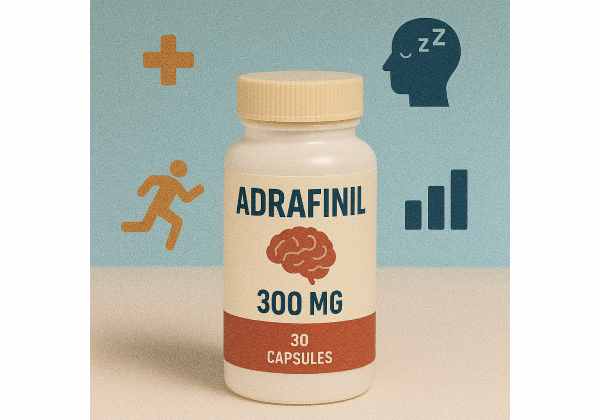
Adrafinil is a synthetic nootropic compound renowned for its potential to promote wakefulness, alertness, and mental performance—qualities that have made it popular among shift workers, students, and those seeking cognitive enhancement. Originally developed in France as a treatment for sleep disorders, adrafinil is now used as a supplement by individuals interested in improving focus and combating fatigue without traditional stimulants. Although its effects and safety profile resemble those of modafinil, adrafinil is unique in being available over the counter in many regions. This guide explores adrafinil’s mechanism, evidence-based benefits, dosage protocols, safety concerns, and expert perspectives to help you make informed decisions.
Key Takeaways
- Adrafinil promotes alertness, focus, and reduced fatigue, making it popular among students and shift workers.
- It is a prodrug of modafinil, sharing many cognitive-enhancing and wakefulness-promoting properties.
- Dosage typically ranges from 300–600 mg per day, with use cycles recommended to avoid tolerance or adverse effects.
- Potential side effects include headache, irritability, elevated liver enzymes, and insomnia if taken too late in the day.
- Always consult a healthcare provider before starting adrafinil, especially if you have liver concerns or take prescription medications.
Table of Contents
- Understanding Adrafinil: Origins and Overview
- The Science Behind Adrafinil: How It Functions in the Brain
- Primary Benefits and Supported Applications
- Risks, Adverse Effects, and Medication Interactions
- Dosage Guidelines, Timing, and Supplementation Tips
- Frequently Asked Questions
Understanding Adrafinil: Origins and Overview
Adrafinil is a synthetic compound that was first developed in the late 1970s by French pharmaceutical company Lafon Laboratories. Initially intended to treat narcolepsy and other sleep-related disorders, it found use as a wakefulness-promoting agent, especially before the widespread availability of modafinil (its active metabolite). Unlike classic stimulants, adrafinil exerts its effects without directly increasing heart rate or blood pressure, making it a unique option for individuals seeking alertness without the “jittery” side effects associated with amphetamines or caffeine.
Key Facts about Adrafinil:
- Chemical Structure: Adrafinil (CRL-40028) is classified as a eugeroic, a class of compounds that enhance wakefulness.
- Legal Status: In many countries, including the U.S., adrafinil is not a prescription drug and can be purchased as a supplement, though its regulatory status varies.
- Conversion to Modafinil: Upon ingestion, adrafinil is metabolized in the liver to produce modafinil, which is responsible for most of its pharmacological effects.
- Historical Use: Adrafinil was marketed under the brand name Olmifon in France until 2011, after which it was discontinued for commercial reasons, not for safety concerns.
Who Uses Adrafinil?
- Shift workers who need to combat excessive daytime sleepiness.
- Students and professionals aiming for improved concentration during demanding tasks.
- Biohackers and nootropic enthusiasts looking for cognitive enhancement tools.
- Older adults interested in counteracting fatigue or age-related cognitive decline.
Distinct Features:
- Non-amphetamine stimulant: Unlike conventional stimulants, adrafinil does not typically cause hyperactivity or agitation.
- Availability: Since adrafinil is not classified as a controlled substance in most places, it’s accessible as an over-the-counter supplement.
Legal and Ethical Considerations:
- While legal in many regions, adrafinil is on the World Anti-Doping Agency’s (WADA) list of prohibited substances for athletes due to its cognitive and performance-enhancing potential.
- Some workplaces may require disclosure or prohibit use due to its conversion to modafinil, which is regulated in certain countries.
Summary Table: Key Properties of Adrafinil
| Property | Details |
|---|---|
| Chemical Class | Eugeroic (wakefulness-promoting) |
| Primary Mechanism | Modafinil prodrug |
| Intended Use | Narcolepsy, fatigue, cognitive boost |
| Typical Dosage Range | 300–600 mg/day |
| Onset of Action | 45–60 minutes |
| Duration | 6–12 hours |
| Regulatory Status | OTC in many regions |
Adrafinil stands out for its wake-promoting effects and is a mainstay in the nootropic community. However, its conversion in the liver and potential for adverse effects necessitate responsible, informed use.
The Science Behind Adrafinil: How It Functions in the Brain
To understand adrafinil’s benefits and risks, it’s vital to grasp how it acts within the body and the brain. The mechanism of action of adrafinil, and its active metabolite modafinil, is multifaceted—affecting several neurotransmitter systems that regulate alertness, motivation, and mental performance.
Metabolism and Activation:
- Prodrug Mechanism: Adrafinil itself is pharmacologically inactive until it is metabolized in the liver, where it is converted into modafinil and inactive modafinilic acid.
- Onset and Duration: Because the conversion takes time, adrafinil’s effects are typically felt 45–60 minutes after ingestion and may last up to 12 hours.
Neurotransmitter Effects:
- Orexin/Hypocretin System: Modafinil, and thus adrafinil, stimulates orexin neurons in the hypothalamus, which are crucial for wakefulness and arousal.
- Dopamine Transporter Inhibition: Modafinil mildly inhibits dopamine reuptake, increasing dopamine levels in the brain’s reward and motivation pathways, which enhances alertness and mood.
- Other Neurotransmitters: It also influences histamine, norepinephrine, glutamate, and GABA levels, contributing to its unique cognitive and wake-promoting profile.
Unique Mechanistic Points:
- Unlike classic stimulants (e.g., amphetamines), adrafinil does not cause a sharp increase in norepinephrine or serotonin, so it’s less likely to induce jitteriness or anxiety.
- Liver Enzyme Induction: Because adrafinil is metabolized in the liver, chronic use can elevate liver enzymes and stress hepatic function, a key consideration for long-term users.
Pharmacokinetics Summary:
- Absorption: Rapid from the gut; not affected by food.
- Half-life: Modafinil’s half-life is ~12–15 hours; adrafinil’s own half-life is shorter, but its conversion extends effect duration.
- Elimination: Metabolites are excreted in urine.
Tolerance and Dependence:
- Most evidence suggests a low risk of addiction or withdrawal, especially when used responsibly. However, regular high-dose or long-term use may blunt effectiveness due to tolerance.
How Does This Translate to Real-World Use?
- Users typically report an increase in focus, sustained attention, wakefulness, and a reduction in mental fatigue. Notably, there is little or no “crash” when the effect wears off, differentiating adrafinil from other stimulants.
- Because of the lag in onset, users are advised to plan their dosing schedules to avoid sleep disturbances at night.
Comparison to Modafinil:
- Adrafinil and modafinil are often considered interchangeable in terms of effect, but adrafinil’s reliance on liver conversion adds a layer of risk for those with hepatic concerns.
In summary, adrafinil works by transforming into modafinil—a compound that elevates alertness, modulates neurotransmitter systems, and supports cognition, with a mechanism that is distinct from conventional stimulants.
Primary Benefits and Supported Applications
Adrafinil is valued in both clinical and nootropic contexts for its ability to foster wakefulness and mental stamina. Its benefits are most apparent in populations facing sleep deficits, shift work fatigue, or periods of intense mental effort.
Clinically Supported Benefits:
- Promotes Wakefulness: Originally prescribed for narcolepsy and idiopathic hypersomnia, adrafinil enables sustained alertness for those struggling with excessive daytime sleepiness.
- Enhances Focus and Mental Performance: Clinical trials and user reports note improvements in attention, vigilance, and the ability to complete complex cognitive tasks under pressure.
- Reduces Perceived Fatigue: Adrafinil can help offset both physical and mental fatigue, making it attractive for those working irregular or long hours.
Cognitive Enhancement and Nootropic Use:
- Memory and Learning: Although not a classical memory enhancer, adrafinil may improve working memory and information retention by facilitating sustained attention.
- Mood and Motivation: Some users report elevated mood, increased motivation, and greater productivity, likely due to modafinil’s action on dopamine pathways.
Other Notable Uses:
- Jet Lag and Shift Work: Adrafinil has been used to help individuals adapt to changing sleep schedules or time zones.
- Age-Related Cognitive Decline: Preliminary research suggests potential for supporting cognitive health in older adults, though more evidence is needed.
Evidence Quality:
- Most clinical data comes from modafinil studies; since adrafinil is a prodrug, its effects are presumed very similar.
- Direct research on adrafinil is less extensive, but user experiences and clinical history are generally supportive.
Limitations:
- Adrafinil does not address the root causes of sleep deprivation or fatigue. It is best used as an adjunct, not a substitute, for healthy sleep and lifestyle habits.
- Not suitable for long-term daily use due to potential liver strain and unknown long-term risks.
Summary Table: Adrafinil Benefits and Applications
| Benefit/Use | Evidence Level | Typical Context |
|---|---|---|
| Wakefulness (narcolepsy) | High | Medical, nootropic |
| Focus/concentration | Moderate | Students, professionals |
| Fatigue reduction | Moderate | Shift workers, travelers |
| Mood/motivation | Limited | Anecdotal, biohacker reports |
| Cognitive aging support | Limited | Elderly, research setting |
When used responsibly, adrafinil can be a powerful tool for acute cognitive and energy needs. However, understanding both its potential and its limitations is essential for safe, effective supplementation.
Risks, Adverse Effects, and Medication Interactions
While adrafinil is widely used for its cognitive and wake-promoting effects, safety is a major consideration—particularly with long-term or high-dose use. Unlike some nootropics, adrafinil is metabolized primarily in the liver, which introduces specific health risks and demands careful use.
Potential Side Effects of Adrafinil:
- Liver Enzyme Elevation: Chronic use can increase liver enzymes (ALT, AST), sometimes to clinically significant levels. This is one of the most serious risks and is not common with modafinil.
- Headache: Frequently reported, possibly related to dehydration or overstimulation.
- Insomnia: If taken late in the day, adrafinil can disrupt normal sleep patterns due to its long duration of action.
- Irritability or Anxiety: Some individuals experience mood changes, restlessness, or mild agitation, particularly at higher doses.
- Gastrointestinal Upset: Nausea, dry mouth, or stomach discomfort can occasionally occur.
- Skin Reactions: Rare reports of rashes or allergic reactions.
Rare or Serious Concerns:
- Liver Damage: Extended use or pre-existing liver disease increases risk; periodic liver function tests are advised for regular users.
- Cardiovascular Strain: Although adrafinil is less likely to raise blood pressure or heart rate than classical stimulants, those with cardiovascular issues should use with caution.
- Dependence/Tolerance: Although not habit-forming in the classical sense, frequent use may reduce effectiveness and increase risk of side effects.
Drug Interactions:
Adrafinil may interact with other medications, especially those metabolized by liver enzymes (CYP450 system). Key considerations include:
- Antiepileptics: May reduce effectiveness of drugs like carbamazepine or phenytoin.
- Anticoagulants: Can alter the effects of blood thinners (e.g., warfarin).
- Hormonal Contraceptives: Reduced efficacy is possible due to induction of certain liver enzymes.
- SSRIs/Antidepressants: May alter the metabolism and levels of some psychiatric medications.
Special Populations:
- Pregnant or Breastfeeding Women: There is no established safety data; use is not recommended.
- Elderly Individuals: Extra caution is required due to potential liver vulnerability.
- Those with Liver or Kidney Disease: Should avoid adrafinil unless under strict medical supervision.
Best Practices for Safe Use:
- Cycle Usage: Limit use to periods of high need; avoid daily long-term supplementation.
- Monitor Liver Health: Consider routine liver function tests if using adrafinil more than occasionally.
- Start Low, Go Slow: Begin with a lower dose and observe individual response.
- Stay Hydrated: Headaches and irritability can be mitigated by adequate fluid intake.
Summary of Safety Precautions:
Adrafinil is generally well-tolerated in healthy adults when used responsibly. However, its metabolism places a unique burden on the liver, making medical oversight and moderation crucial. Always consult your healthcare provider if you have underlying health conditions, take regular medications, or experience unexpected side effects.
Dosage Guidelines, Timing, and Supplementation Tips
Achieving the benefits of adrafinil while minimizing risks depends heavily on using the correct dosage, timing, and administration practices. Since individual responses can vary, it’s best to start conservatively and adjust as needed.
Typical Dosage Recommendations:
- Standard Dosage: Most users take between 300 mg and 600 mg per day, often split into two doses if needed.
- Starting Dose: Beginners are advised to start at 200–300 mg to assess tolerance.
- Maximum Recommended Dose: Clinical and user experience suggests not exceeding 600 mg in a 24-hour period.
Administration and Timing:
- Morning Use: To prevent insomnia, adrafinil should be taken in the morning or early afternoon.
- On an Empty Stomach: Absorption may be slightly faster; however, taking with food can minimize stomach upset.
- Cycling: Limit use to a few days per week or reserve for periods of acute need to avoid building tolerance and stressing the liver.
How to Take Adrafinil Safely:
- Measure Accurately: Use a milligram scale if using powder form; capsules provide more precise dosing.
- Stay Hydrated: Drink water before and after dosing to counteract mild diuretic effects and reduce headache risk.
- Monitor for Side Effects: Discontinue use if you notice signs of liver dysfunction (jaundice, fatigue, dark urine) or other adverse effects.
- Liver Function Tests: If using for more than a few weeks, consider periodic bloodwork to check liver enzymes.
Tips for Maximizing Benefits:
- Combine with Healthy Sleep Practices: Adrafinil is not a substitute for sleep; use to supplement, not replace, rest.
- Stacking: Some users pair adrafinil with choline supplements or adaptogens for added cognitive support, but combinations should be approached with caution.
- Avoid Late Dosing: Effects may last 8–12 hours; taking adrafinil after noon increases the risk of sleep disruption.
Cautions and Contraindications:
- Avoid Use with Alcohol: Both can strain the liver and increase risk of adverse effects.
- Do Not Combine with Other Stimulants: This may lead to overstimulation and increased side effects.
Summary Table: Adrafinil Dosage and Use
| Scenario | Dosage | Timing | Notes |
|---|---|---|---|
| First-time user | 200–300 mg | Early morning | Assess tolerance |
| Typical usage | 300–600 mg | Morning | 2–3 days per week, max |
| Extended periods | Not recommended | — | Monitor liver function |
By following these guidelines and maintaining open communication with your healthcare provider, you can maximize the benefits of adrafinil while minimizing risks.
Frequently Asked Questions
What is adrafinil used for and how does it work?
Adrafinil is used to promote wakefulness, alertness, and cognitive performance. It is a prodrug that converts into modafinil in the liver, acting on neurotransmitters that regulate attention and energy without typical stimulant side effects.
Is adrafinil legal and do you need a prescription?
In most countries, adrafinil is available over the counter and does not require a prescription. However, regulations may vary, and some regions restrict its sale or use, especially in athletic competitions.
What are the most common side effects of adrafinil?
Common side effects include headache, insomnia, irritability, and gastrointestinal discomfort. The most serious risk is elevated liver enzymes with long-term use, so periodic liver monitoring is advised.
How much adrafinil should you take for cognitive enhancement?
A typical dosage for cognitive enhancement is 300–600 mg, taken in the morning. Beginners should start at the lower end of the range to assess tolerance and minimize side effects.
Can you take adrafinil every day?
Daily use is not recommended due to the risk of liver strain and potential for tolerance. Most experts suggest limiting adrafinil to occasional or short-term use, with breaks between cycles.
Is adrafinil safe for long-term use?
Long-term safety data is limited. Because it can elevate liver enzymes, prolonged use is discouraged without medical supervision. Regular users should undergo periodic liver function tests.
Does adrafinil show up on drug tests?
Adrafinil metabolizes into modafinil, which can be detected in some drug screenings. Athletes should note that both compounds are banned by major sports organizations.
Disclaimer:
The information presented in this article is for educational purposes only and does not constitute medical advice. Always consult a qualified healthcare provider before beginning any new supplement, especially if you have preexisting conditions or are taking prescription medications. Individual results may vary.
We hope you found this guide to adrafinil informative and empowering! If you found value in this article, please share it on Facebook, X (formerly Twitter), or your favorite platform—and consider following us on social media. Your support helps us continue providing trustworthy, evidence-based health content for everyone. Thank you!










